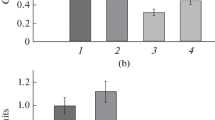Summary
An electron microscopic examination of the fine structure of giant mast cells in the peritoneal fluid of the rat was made. The giant mast cells were produced by irradiating rats with a microwave apparatus generating energy of a frequency of 2,425±25 megacycles.
The most obvious features of the giant mast cell appeared to be abundant swelling of the cytoplasm, which increased the distance between the granules, and the partial disappearance of the granules. Disruption of the mast cells, with escape of the granules, was not observed. Whether the formation of the giant mast cells is a reversible process or not cannot be answered on the basis of the present study.
Similar content being viewed by others
References
Bloom, G. D., and Ö. Haegermark: A study on morphological changes and histamine release induced by compound 48/80 in rat peritoneal mast cells. Exp. Cell Res. 40, 637–654 (1965).
Luft, J. H.: Improvements in epoxy resin embedding method. J. biophys. biochem. Cytol. 9, 409–414 (1961).
Padawer, J.: Effect of colchicine and related substances on the morphology of peritoneal mast cells. J. nat. Cancer Inst. 25, 731–747 (1960).
Padawer, J., and A. S. Gordon: Effects of colchioine on mast cells of the rat. Proc. Soc. exp. Biol. (N.Y.) 88, 522–525 (1955).
Reynolds, E. S.: The use of lead citrate at high pH as an electron-opaque stain in electron microscopy. J. Cell Biol. 17, 208–212 (1963).
Riley, J. F.: Functional significance of histamine and heparin in tissue mast cells. Ann. N.Y. Acad. Sci. 103, 151–163 (1963).
Sabatini, D. D., K. Bensch, and R. J. Barrnett: Cytochemistry and electron microscopy. The preservation of cellular ultrastructure and the enzymatic activity by aldehyde fixation. J. Cell Biol. 17, 19–58 (1963).
Uvnäs, B.: Mechanism of histamine release in mast cells. Ann. N.Y. Acad. Sci. 103, 278–284 (1963).
Valtonen, E. J.: Giant mast cells — a special degenerative form produced by microwave radiation. Exp. Cell Res. 43, 221–224 (1966).
—, J. Jänne, and M. Siimes: The effect of the erythemal reaction caused by ultra-violet irradiation on mast cell degranulation in the skin. Acta derm.-venereol. (Stockh.) 44, 269–272 (1964).
Wegelius, O., G. Hjelmman, and C. Wasastjerna: Morphological changes caused by anti-hamster serum in the mast cells of the hamster. Acta path. microbiol. scand. 36, 309–315 (1955).
Author information
Authors and Affiliations
Additional information
It is a pleasure to acknowledge the skilful assistance of Miss Tellervo Huima and Mr. Mauri Nyholm, M. Sc.
This study is supported by the PAULO Foundation.
Rights and permissions
About this article
Cite this article
Valtonen, E.J. Observations on the fine structure of giant mast cells produced by microwave radiation of the peritoneal fluid. Zeitschrift für Zellforschung 80, 322–328 (1967). https://doi.org/10.1007/BF00339325
Received:
Issue Date:
DOI: https://doi.org/10.1007/BF00339325



